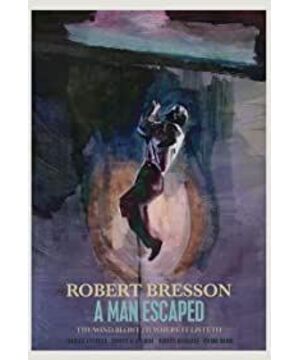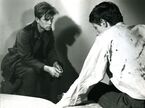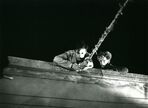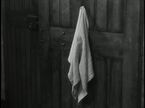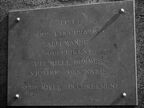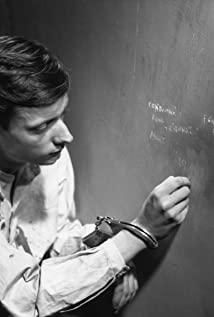The shots in "Un condamné à mort s'est échappé ou Le vent souffle où il veut" are almost frozen. Most of them are a superposition of medium shots and close-ups. Director Bresson does not like to use distant shots, so I can’t speculate on the actual structure of this prison. And the area—so it creates a lingering sense of tension. With a little attention, the Nazi secret police and guards have no facial features, which also poses a potential threat in the background. Coupled with the gunshots from time to time, the possibility of the protagonist's escape plan is very slim.
In fact, this kind of escape finally feels like a kind of precise calculation and psychological endurance, and any calculation error in a detail will lead to failure. Moreover, Bresson allowed this calculation to continue and aggravate within 100 minutes, and the audience just entered the psychological ups and downs of the character and worried about his fate. The protagonist Von Dyner does not seem to be a very strong person, and he is a bit fragile in terms of size and demeanor. When he learned that he had been included in the execution list, he lay down on the bed and wept loudly, but at the same time you can see the determination to act immediately from the look in his eyes.
There are many close-ups of Von Dina's back prying open the prison door, and even close-ups of holding a spoon. This is the static state of life hitting the door panel. Because of the long wait and the torture of slow progress, it is completely beyond the tolerance of people. To build a great psychological wall that struggles with destiny, the thick walls are transformed into fragile nerve endings at a certain moment.
A very stressful movie, it calculates the length of life on the edge of death. Tension is also appearance. "Un condamné à mort s'est échappé ou Le vent souffle où il veut" is the most poetic respect for life.
In "Un condamné à mort s'est échappé ou Le vent souffle où il veut", Bresson arranged the length of Von Dyne's life. From the cell to the wall, it was tens of meters, but it was Von Denne's life length. Every time Von Dina wanted to add a meter, he had to bear more weight. He made all the available fabrics into a few long ropes to sustain life and death. Bresson spent nearly one-fifth of the film's time to film the final implementation of the action. The treatment of the character's psychology is almost always a close-up shot and the conversion of time. Bresson is a genius who has the ability to freeze time and find the exit of the soul.
Von Dyne has been looking for partners in action, but everyone, including the mysterious old man in the next room, did not respond, even though they hope Von Dyne will succeed in order to achieve the very remote inner survival expectations. It is conceivable that they have accepted the ending of death, very calm and very pessimistic.
Before leaving, Von Dyne knocked a few times on the wall shared with the next door, and the old man responded a few times. Von Dina had no expression on his face, but it revealed the kind of loving care, the farewell to the death hole and the final attention to life. These may be the sounds in the black and white tones that infect us, with a very deep silence.
In this film, the use of sound and images has reached a height that can be written into a film history textbook. Bresson's use of sound has always been admirable. The coordination of the sound outside and inside the painting has a first-rate effect on the rendering of the atmosphere and the portrayal of the characters' psychology. The same is true in this film, whether it’s the coughing outside, the faint footsteps in the empty corridor, or the roaring, bird calls, and bicycle wheels rolling in the square that he and Jost heard on the roof. The voices all create an incomparably real atmosphere, allowing people to follow Von Dina immersively, beating with him, being excited, and sweating together. When it comes to photography, the sophisticated photography of this film can be described as "extremely ingenious". The unchanging camera position and the minimally changing angle are extremely sophisticated behind the simplicity. For example, the peephole at the entrance of Fontaine is the only hole he observes in the corridor of the prison, but the image that can be observed has told the audience the whole story. It's like Orsini was arrested and returned to the room after escaping. There was no bloody scene of sprinkling dog blood or screaming torn eardrums. It was just the escort of a Nazi officer. Two muffled hums behind the door of the room were enough. Let people know what they can’t see
.
The artistic power of Bresson is, first of all, a simple style, which is better to be omitted than extravagant; secondly, the close-up of the characters is meaningful and the excavation of the things behind the expression; secondly is the use of amateur actors. In his opinion, the actors should Get rid of acting skills, so he likes to call his amateur actors "models"; there is also the application of narration ("Un condamné à mort s'est échappé ou Le vent souffle où il veut"), a psychology derived from literature Analysis; the other is the composition and editing that are boldly close to painting, according to what he said-"cutting, the image of death transitions to the image of life, everything blooms again".
If Bresson had these characteristics, it would not be great enough. His greatness came from his feelings --- the spiritual examination hidden behind the character.


